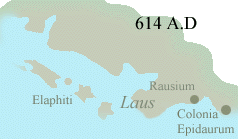 |
The foundation
of Dubrovnik |
The present area of Dubrovnik and the surrounding region was settled by Illyrians in the 3rd century B.C..
They also populated the nothern region of Greece (Doris), reached Palestine under the name Philistines and, as pirates, were feared by the Ancient Greeks. Unlike the piratical Illyrians, the Greek colonies in the coastel area and the Dalmatian islands off the coast, placed themselves under the protection of Rome. In the 2nd century B.C., the Romans founded the province of Illyricum, but did not conquer it until 35 -33 B.C. under Octavian (Augustus) and finally, in 9 A.D. under Tiberius.
|

Augustus |
The Roman Illyricum, divided into the provinces
of Dalmatia and Pannonia, was the native country of several roman emperors of the 3rd and 4th centuries A.D. (among them, the emperor Diocletian, whose residence and palace is situated in Split, the capital of Dalmatia).
|
| In the area of the present-day town of Cavtat, the Romans established a colony at Epidaurum, and on the large peninsula Laus (wich means rock in Greek) they founded a settlement, Rausium. |
|
In the 7th century A.D., the Avars and Slavs invaded the Roman colony. The few surviving inhabitants took refuge in the nearby settlement of Rausium. Rausium became known as "Epidaurum, id est Ragusium" (referred to in 614 A.D. by an unknown geogapher in Ravenna - North Italy). Rich and thick oak woods surrounded the settlements, and the origin of the name Dubrovnik comes from the Slav word for oak - "dub". "Epidaurum, id est Ragusium" was under the suverainty of Byzantinium from 614 - 1205, and in that period strived by means of commerce and skillful diplomacy to preserve its freedom and independence. From the little settlement developed an important commercial city-state. The growing influence of the Slav element in the population eventually led the inhabitants of "Epidaurum, id est Ragusium" (in Italian: Ragusa) to name the city Dubrovnik. The oldest mention of the Slavic name for the city dates from 1189 A.D. (in the charter of Banus Kulin). |
|
 |

